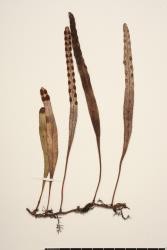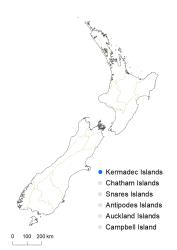- ≡ Polypodium serpens G.Forst., Fl. Ins. Austr. 81 (1786)
- ≡ Niphobolus serpens (G.Forst.) Endl., Prodr. Fl. Norfolk. 8 (1833)
- ≡ Craspedaria serpens (G.Forst.) C.Presl, Epimel. Bot. 263 (1851)
- ≡ Cyclophorus serpens (G.Forst.) C.Chr., Index Filic. 201 (1905)
Low epiphytic ferns. Rhizomes long-creeping, 1–1.5 mm diameter, densely scaly. Rhizome scales peltate, ovate, 2–2.8 mm long, 0.7–0.9 mm wide, appressed, dark brown centrally, becoming orange-brown and colourless on the margin; margins dentate to ciliate. Stipes winged for much of their length and indistinct from the attenuate lamina base. Fronds undivided; sterile fronds narrowly elliptic, 90–110 mm long (including stipe), 9–15 mm wide; fertile fronds narrowly elliptic to narrowly ovate or narrowly oblong, 115–175 mm long (including stipe), 7–10 mm wide; apex acute to obtuse, margins entire, base attenuate to an indistinct stipe, dark green, coriaceous to succulent, scattered stellate hairs on adaxial surface, densely covered in mostly silver-coloured stellate hairs on abaxial surface. Veins obscure, hydathodes absent or indistinct. Sori slightly elongate, 3–5 mm long, sunken in the lamina and protuberant on adaxial surface, arranged in one row either side of midrib, not confluent, confined to distal part of lamina, paraphyses present as stellate hairs, exindusiate.
Pyrrosia serpens is very similar to P. elaeagnifolia, and both species have been recorded from the Kermadec Islands. Fronds of P. serpens are generally narrower (9–15 mm wide) and more oblong in shape than those of P. elaeagnifolia, which are broader (11–31 mm wide) and more ovate or elliptic in outline. The rhizome scales of P. serpens are appressed, ovate in outline, 2–2.8 mm long, slightly ciliate, and have a conspicuous dark centre, whereas those of P. elaeagnifolia are squarrose, narrowly ovate in outline, 2–7 mm long, entire, and concolorous. However, the most obvious distinguishing character is the arrangement of the sori, which, in P. serpens, are arranged in one row either side of the midrib, often partly sunken into the lamina and protuberant on the adaxial surface, whereas in P. elaeagnifolia they are in two to five rows, superficial on the abaxial surface and not protuberant on the adaxial side.
Kermadec Islands.
Known only from one collection made at 58 m on Dayrell Island, Herald Islets, Kermadec Islands.
Also occurs in Fiji, Cook Islands, Society Islands, Austral Islands, Gambier Islands, Pitcairn Island and Henderson Island (Hovenkamp 1986). Its occurrence on Easter Island is uncertain. Hovenkamp (1986) cited one 19th century specimen in M from Norfolk Island (Hügel s.n.), but Green (1994) asserted that only P. confluens was present on the island.
On the basal trunk of Metrosideros kermadecensis in summit forest.
Polypodium serpens was first described by Forster (1786) and said by him to have come from New Zealand. However the lectotype (BM 001048427) is not conspecific with the species from mainland New Zealand, and almost certainly came from one of the Pacific Islands (Hovenkamp 1986). Carruthers (in Seemann 1865–1873) suggested that the locality should be the Society Islands rather than New Zealand, and a French Polynesian origin for the lectotype appears probable given the distribution of the species and Forster’s itinerary; he apparently did not collect during his visit to the Cook Islands (Sykes 2016). Brownsey et al. (2021) showed that the circumscription of Pyrrosia serpens requires further investigation.





